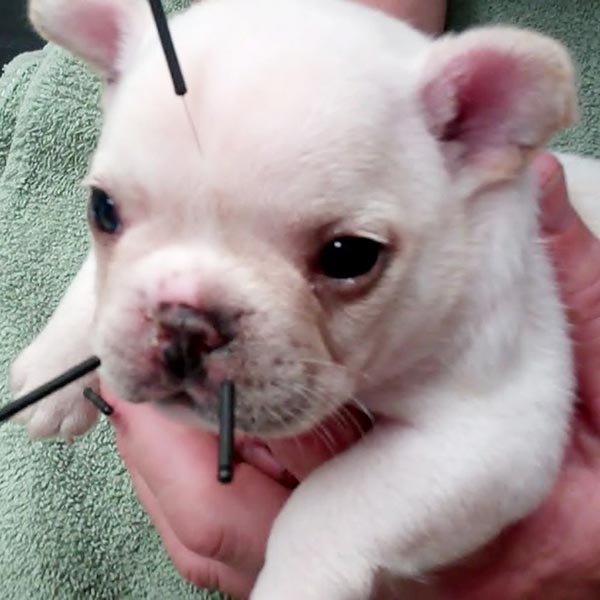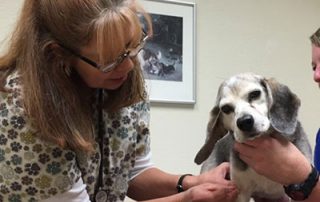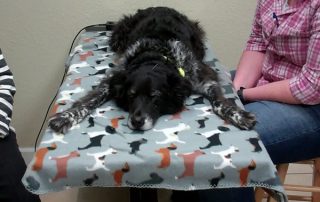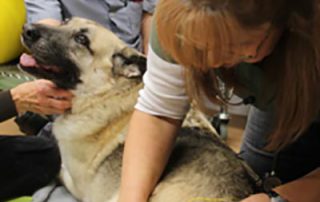Project Description
Acupuncture and Herbal Therapies Improves Your Pet’s Quality of Life
These treatments are part of Traditional Chinese Veterinary Medicine. Many of us have heard of these therapies or even experienced them, for humans. Did you know that they are also very effective for animals?
Acupuncture and herbal therapies are two branches of Traditional Chinese Veterinary Medicine. The other three branches include food therapy, Tui-na and Qi-Gong. They are often used in combination to achieve better health.
- Traditional Chinese Veterinary Medicine focuses on correcting imbalances in the body and its goal is to treat the root cause of disease. Using these “tools” together in an integrative way, with or without, conventional therapy supports a pet’s ability to recover.
- In 2003, the World Health Organization listed 28 symptoms and diseases with scientific proof confirming that acupuncture is beneficial.
- Acupuncture has evolved over hundreds to thousands of years. Zhao Fu and Bo Le, historical Chinese veterinary acupuncturists, practiced around 947 to 928 BC and 659 to 621 BC
- Through careful observation, the ability to determine consistent responses to acupuncture treatments have been established and is scientifically repeatable.
In 2010, a study by Joaquim published in the Journal of American Veterinary Medicine Association showed that 40 dogs with severe neurological signs secondary to disc disease, responded better to electroacupuncture compared to surgery. There was 78% improvement with electroacupuncture versus decompressive surgery at a 40% success rate.
How does Acupuncture Help Patients?
- It offers another treatment option where there are limited choices.
It offers a non-invasive treatment option.
Acupuncture has a very low risk of side effects (White in 2004 reviewed over one million acupuncture treatments in people and found the risk of a serious side effect is 0.05 in 10,000 treatments).
- It is well tolerated by pets.
Acupuncture is effective.
What are the Goals of Acupuncture?
- Relieve or decrease of pain.
- Minimize or treat the side effects of disease.
- Treat conditions where other modalities have failed.
- Return the pet to its function or to activities of daily living.
- Speed recovery time from an injury or disease.
How Does Acupuncture Work?
- There are over 400 acupoints located on the body.
- In Traditional Chinese Medicine theory, each acupuncture point is associated with an internal function and organ.
- Most of the acupoints run along a meridian system which is a series of channels that run throughout the body.
- They are interconnected and work together to promote cellular changes that modify health.
- These acupoints are in areas where there is a high density of free nerve endings, arterioles, lymphatic vessels and mast cells. They can be found where nerves bifurcate and where nerves penetrate the onto the muscle fascia.
An example of scientific confirmation of acupuncture includes a study by Kim in 2009 that showed when acupuncture points (BL-18,20,23) were injected with MRI contrast agent, the contrast agent was found in the target organ.
In another study, radioisotopes were injected into an AP point then the radioisotope travel along the meridian to other points. Injections at non-acupuncture sites did not have the same response.
Research has shown that the following physiologic changes take place and may explain why Acupuncture works:
- There is counter-irritation created by the needle that creates a mild local tissue trauma. The trauma causes mast cell degranulation and activation of the coagulation and complement cascade causing increased blood flow to that area. Also stimulation of points cause changes in the signaling molecules like opioid peptides, glutamate, hydroxytryptamine, and cholecystokinin, etc.
- Stimulation of an acupoint causes activation of Aβ and Aα fibers which conducts electrical impulses through the spinothalamic tract which then causes the release of endorphins.
- Acupuncture causes input from large myelinated Aβ fibers which transmit innocuous sensations of touch then activate inhibitory interneurons in the spinal cord which inhibits projection neurons in the brain.
- In 2003, it was discovered that acupuncture also activates T-cell lymphocytes.
What are some of the common conditions or symptoms that acupuncture is recommended to treat?
Pain
Nerve malfunction or injury
Vomiting
Diarrhea
Constipation
Seizures
Paralysis/paresis
Cough
Liver and kidney disease
Urinary incontinence
How many treatments may a pet need?
The number of treatments depends on the condition being treated. Acupuncture is cumulative, even treatments that are spaced apart have benefits.
Depending upon the duration of the condition being treated, a minimum of 4 treatments every week to 2 weeks is recommended.
Does acupuncture hurt and are there other methods of delivery besides using needles?
- Because of the small size of the needles, the treatments are usually well received. If fact, many pets fall asleep during the session.
Typically the use of very tiny and thin needles is the most common form of Acupuncture.
Electroacupuncture applies an electrical current through the Acupuncture sites and it is very soothing. The treatment affect lasts longer than other methods of stimulation.
Aquapuncture is the injection of fluids like saline or vitamin B into acupuncture points.
Moxibustion is the warming of an acupuncture point by indirectly moving a lighted moxa stick over the site or by briefly touching the stick to the needle.
Laser stimulation of acupuncture points can be used in patients that have an eversion to needles.
Other methods of acupuncture delivery include pneumoacupuncture, material implants like titanium wire and hemoacupuncture.
Key Points
Acupuncture offers a safe method of treating a variety of conditions.
It offers a treatment option for conditions that are difficult to treat or have no conventional treatment available.
Herbal Therapy: What Is It and How Does It Work
Herbal formulas are often used as a single treatment or as part of an integrative care plan. Combining herbal formulas with conventional drugs will often enhance the pet’s recovery or slow the progression of a disease. Dr. Shearer is trained in use of Chinese herbal therapies to help manage disease processes ranging from digestive and respiratory disorders to pain and cancer support.
Unlike Western herbs, Chinese herbal formulas use a combination of herbs to achieve a desired effect that most often has additional health benefits. For example, the herbal formula Ming Mu Di Huang (developed in 1644) helps to manage eye problems, but also supports kidney and liver health. The pharmaceutical background of one of herbals in the formula (Sheng Di Huang) contain iridoidal glycosides.Studies have revealed that iridoids have neuroprotective, anti-inflammatory, immuno-modulating, hepatoprotective, cardioprotective, anticancer, anti-oxidant, antimicrobial, hypoglycaemic, hypolipidaemic, choleretic, antispasmodic and purgative properties.
All herbal formulas used by Dr. Shearer are purchased from Jing Tang Herbal, Inc., a company that has developed and manufactured herbal products since 1999. All of the herbal products are manufactured strictly in compliance with cGMP regulations and standards. Jing Tang brand herbal products are distributed exclusively through licensed doctors for the best and safest care of the consumers. Over 200 Jing Tang brand formulas have been developed by Dr. Huisheng Xie, based on a history of 3000 years of traditional Chinese herbal recipe and his over 30 years of clinical experience.
Food Therapy and Tui-na
In addition to acupuncture and herbal therapies, nutrition and food therapy may also affect recovery outcome and is used in TCVM. According to TCVM, certain foods have cooling, warming, and healing properties. The choice of the correct food helps to put the body back in balance and again is more supportive of healing.
Tui-na is a form of manual therapy that utilizes various manipulations to acupuncture points and limb stretching movements to improve quality of life. Qi-gong is a form of energy exercise based on meditation to reduce stress for the pet’s caretaker or veterinarian to utilize. This reduction in stress allows for better focus thus helping with recoveries.







